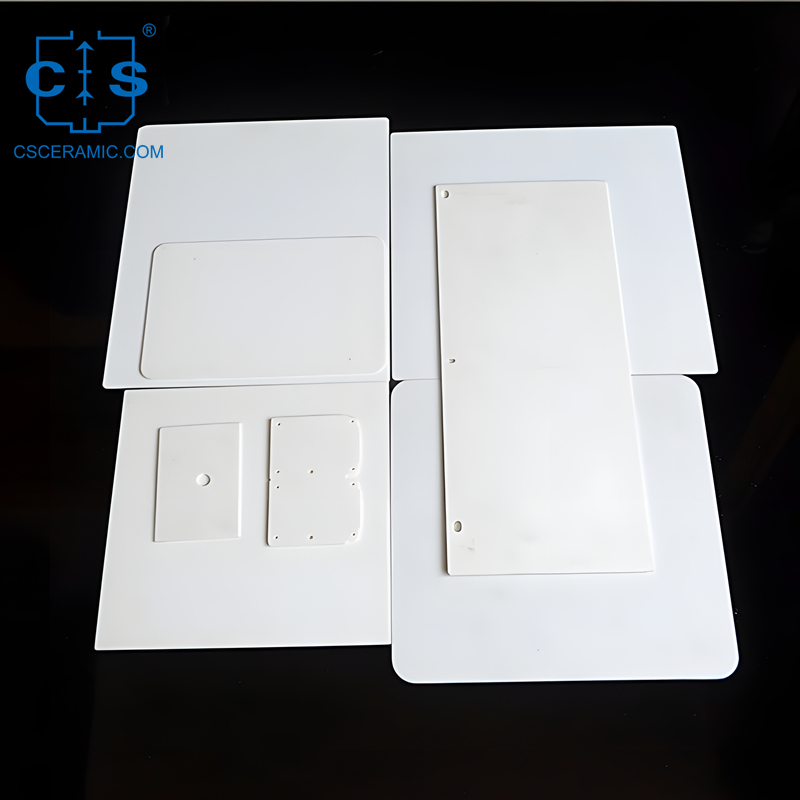Alumina ceramic plates stand out for their unparalleled resilience and multifaceted functionality, transcending boundaries in their application spectrum. From the rigorous demands of industrial settings to the delicate intricacies of medical practices, they consistently demonstrate their worth.
In the realm of industrial applications, alumina ceramic plates occupy a pivotal position, owing to their unparalleled tolerance to extreme temperatures, chemical erosion, and abrasive wear. This renders them invaluable in manufacturing processes that confront harsh conditions, including the presence of corrosive chemicals and intense heat.
Moreover, the adaptability of alumina ceramic plates extends far beyond industrial usage. Within the medical sector, they occupy a distinguished place, leveraging their impeccable biocompatibility and unparalleled rigidity to excel as implants and prosthetic components. Their resilience and durability contribute to the development of long-lasting, dependable solutions.
Additionally, alumina ceramic plates are a staple in the electronics industry, where their superior electrical insulating properties and thermal conductivity properties are highly prized.
Given their remarkable versatility and longevity, it is evident why alumina ceramic plates have permeated diverse sectors, becoming an indispensable asset in numerous industries thanks to their strength, durability, and resistance to a wide array of environmental factors.

Properties of Alumina Plates
Distinguished by their unparalleled blend of attributes, alumina ceramic plates stand as a remarkable engineering marvel, coveted for their versatility across diverse applications. At their essence lies aluminum oxide, an esteemed ceramic material renowned for its unparalleled toughness, resilience, and steadfastness against thermal fluctuations. Notably, these plates boast a Mohs hardness rating of 9, positioning them just beneath diamond in terms of hardness, thereby offering formidable resistance to scratches, abrasion, and wear-and-tear. This ruggedness underpins their exceptional durability, ensuring resilience in rigorous industrial and medical settings alike. Furthermore, alumina ceramic plates excel in their thermal performance, displaying both superior heat conductivity for efficient thermal transfer and remarkable insulation properties, a rare combination that renders them invaluable in high-temperature applications, such as industrial furnaces, gas turbine systems, and sophisticated electronics.
Advantages of Using Al2O3 Plates
Alumina ceramic plates stand out as a premier material choice across diverse industries, owing to their exceptional suite of benefits. Chief among these is their remarkable durability and lifespan, stemming from unparalleled hardness, resilience, and resistance to abrasion, corrosion, and thermal extremes. Their adaptability is another notable asset, enabling customization to suit specific needs across automotive, aerospace, medical, and electronic sectors. The plates' resilience to harsh temperatures, corrosive media, and mechanical stresses positions them as the go-to option for demanding applications. Moreover, their superior thermal management capabilities, combining high thermal conductivity for efficient heat dissipation with insulation properties safeguarding sensitive elements, render them indispensable in thermal-critical applications like electronics and high-performance engines. Long-term cost-effectiveness is yet another plus, as their exceptional longevity translates into reduced replacement and maintenance costs, justifying the initial investment, especially in industries with stringent operational requirements.
Aluminum Oxide Plates in The Manufacturing Industry
The manufacturing industry has long recognized the versatility and durability of alumina ceramic plates, and their applications in this sector continue to expand. These plates have become an essential component in a wide range of manufacturing processes, contributing to increased efficiency, productivity, and product quality.
One of the primary applications of alumina ceramic plates in the manufacturing industry is in the fabrication of cutting tools and abrasive components. The exceptional hardness and wear resistance of these plates make them an ideal choice for use in tools and equipment that are subjected to high levels of stress and abrasion. Alumina ceramic plates are commonly used in the production of cutting inserts, grinding wheels, and other machining tools, helping to extend the lifespan of these critical components and improve the overall efficiency of manufacturing operations.
In the field of industrial furnaces and high-temperature processing equipment, alumina ceramic plates have become an indispensable material. Their exceptional thermal stability and resistance to thermal shock make them well-suited for use in the construction of furnace linings, heat shields, and other components that are exposed to extreme temperatures. The ability of alumina ceramic plates to withstand these harsh conditions without compromising their structural integrity helps to ensure the reliable and efficient operation of these critical manufacturing systems.
Another important application of alumina ceramic plates in the manufacturing industry is in the design and construction of jigs, fixtures, and other tooling components. The exceptional dimensional stability and resistance to deformation of these plates make them an ideal choice for use in applications where precise positioning and alignment are crucial. Alumina ceramic plates are commonly used in the fabrication of precision molds, dies, and other tooling components, helping to improve the quality and consistency of manufactured products.
Beyond their use in cutting tools and high-temperature equipment, alumina ceramic plates are also finding applications in the production of various industrial components and parts. Their resistance to wear, corrosion, and chemical attack makes them an ideal choice for use in components that are exposed to harsh operating environments, such as those found in the mining, oil and gas, and chemical processing industries. The versatility and longevity of alumina ceramic plates help to reduce maintenance costs and improve the overall reliability of these critical manufacturing systems.
As the manufacturing industry continues to evolve, the exceptional properties of alumina ceramic plates will become increasingly important in driving innovation and improving the efficiency and productivity of a wide range of industrial processes. The versatility and durability of these plates will continue to make them an invaluable asset in the quest for sustainable and high-performance manufacturing solutions.
Conclusion
This essay underscores the invaluable role played by alumina ceramic plates in manufacturing industries, owing to their unparalleled adaptability and enduring longevity. Their exceptional features, including unparalleled hardness, steadfast thermal endurance, impeccable electrical non-conductivity, and formidable resistance to chemicals, have made them a cornerstone in a wide array of pivotal applications.
Peering into the future, it is evident that the appetite for alumina ceramic plates will proliferate as industries endeavor to innovate towards greater efficiency, dependability, and environmental consciousness. The plates' unmatched ability to thrive in extreme environments and perform flawlessly under stringent conditions will become increasingly invaluable as technological progress amplifies the need for cutting-edge materials that can withstand the test of time.




 info@csceramic.com
info@csceramic.com







 +86 18273288522
+86 18273288522